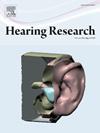Active control of transverse viscoelastic damping in the tectorial membrane: A second mechanism for traveling-wave amplification?
IF 2.5
2区 医学
Q1 AUDIOLOGY & SPEECH-LANGUAGE PATHOLOGY
引用次数: 0
Abstract
Observations from optical coherence tomography (OCT) have revealed a velocity gradient across the reticular lamina in response to sounds (Cho and Puria, 2022). Since viscoelastic forces depend on velocity gradients, this finding suggests that OHC activity may influence viscous loss in the cochlea. Here, we propose a candidate mechanism for regulating traveling-wave viscous dissipation which involves the tectorial membrane (TM). We hypothesize that the velocity gradient generated in the OHC region, combined with TM structural properties, can reduce transverse deformations in the TM and, subsequently, transverse viscous damping. Based on this hypothesis and a simplified mechanical model, we derive a formula for an equivalent basilar membrane (BM) admittance in both passive and active scenarios. We use the WKB approximation to simulate traveling waves in response to tones at different stimulation levels. The calibration of the model is based on OCT data from mice, including data on TM motion. Our simulations show that modulating the viscous load affects the traveling wave in the peak region, with changes in BM velocity magnitude of up to 10 dB. The inclusion of a more classical anti-damping term is necessary to capture the full dynamic range of the response gain. With the textbook view of OHCs acting directly on the BM under re-evaluation in light of recent OCT data, the control of viscous damping in the TM emerges as a viable candidate for a second mechanism governing traveling-wave amplification.
被膜横向粘弹性阻尼的主动控制:行波放大的第二种机制?
光学相干断层扫描(OCT)的观察揭示了网状层对声音的响应速度梯度(Cho和Puria, 2022)。由于粘弹性力依赖于速度梯度,这一发现表明OHC活性可能影响耳蜗的粘性损失。在此,我们提出了一种与被膜(TM)有关的行波粘性耗散调节机制。我们假设热盐区产生的速度梯度,结合TM的结构特性,可以减少TM的横向变形,从而减少横向粘滞阻尼。基于这一假设和简化的力学模型,我们推导出了被动和主动情况下基底膜导纳的等效公式。我们使用WKB近似来模拟不同刺激水平下音调的行波响应。模型的校准基于小鼠OCT数据,包括TM运动数据。我们的模拟表明,调制粘性载荷会影响峰值区域的行波,BM速度的变化幅度可达10 dB。包含一个更经典的抗阻尼项是必要的,以捕获响应增益的整个动态范围。根据最近的OCT数据,教科书中认为热盐直接作用于基底膜的观点得到了重新评估,因此,在基底膜中控制粘性阻尼成为控制行波放大的第二种可行机制。
本文章由计算机程序翻译,如有差异,请以英文原文为准。
求助全文
约1分钟内获得全文
求助全文
来源期刊

Hearing Research
医学-耳鼻喉科学
CiteScore
5.30
自引率
14.30%
发文量
163
审稿时长
75 days
期刊介绍:
The aim of the journal is to provide a forum for papers concerned with basic peripheral and central auditory mechanisms. Emphasis is on experimental and clinical studies, but theoretical and methodological papers will also be considered. The journal publishes original research papers, review and mini- review articles, rapid communications, method/protocol and perspective articles.
Papers submitted should deal with auditory anatomy, physiology, psychophysics, imaging, modeling and behavioural studies in animals and humans, as well as hearing aids and cochlear implants. Papers dealing with the vestibular system are also considered for publication. Papers on comparative aspects of hearing and on effects of drugs and environmental contaminants on hearing function will also be considered. Clinical papers will be accepted when they contribute to the understanding of normal and pathological hearing functions.
 求助内容:
求助内容: 应助结果提醒方式:
应助结果提醒方式:


